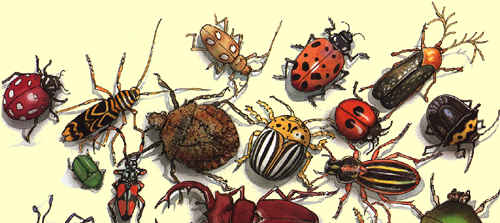 |
 |
 |
Variations
on a Theme
The beetle, with some 300,000 separate species (the world's most numerous order), displays every imaginable color, decorative motif, and proportional distribution of body parts - yet the pattern of relationships that makes the species all beetles is constant. |
| Life
hangs on to what works. At the same time, it explores
and tinkers. This restless combination leads to a vast
array of unique living creatures based on a considerably
smaller number of underlying petterns and rules. For example,
when cells divide and grow, they do so in a mere handful
of ways. New cell scan form concentric rings, as they
do in tree trunks and animal teeth. They can form spirals,
as in snail's shells and ram's horns; radials, as in flowers
and starfish; or branches, as in bushes, lungs, and blood
vessels. Organisms may display several combinations of
these growth patterns, and the scale can vary; but for
all life's diversity, few other growth patterns exist. |
| Life,
instriving for the most economical use of space, borrows
mathematical rules. For instance, count the branches coming
off a stem for a given number of full turns around the
stem, and with surprising consistency the numbers of turns
and branches relate to each other as in the series 1 1
2 3 5 8 13 21... - the so-calles Fibonacci series - in
which each successive number is the sum of the two preceding
it. Thus, in a pine cone, there are thirteen scales for
every eight turns. Similar patterns occur in the spirals
of florets in sunflowers and dasies, the sections of the
chambered nautilus, even the branchings of the bronchial
tubes in our lungs. Such similarities in pattern give
us some insight into how simple rules, used in different
contexts, can provide great variety. From a few notes,
nature creates many symphonies. |
|
|
|





